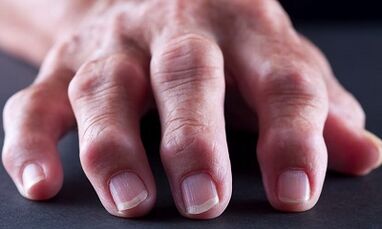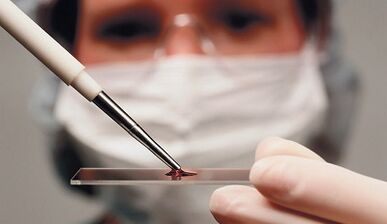Arthritis and arthritis are diseases in which the joints are affected.Since the names of these diseases are in line, many people have opinions on their identity.They perceive these terms as synonyms, suggesting that this is the same disease.However, arthritis and arthritis are far from the same, and there is a significant difference between it.To understand how arthritis is different, let's find out what these diseases are.
What is arthritis?
Arthritis is a collective term that implies the inflammation of each node and most often indicates wider and serious pathological disorders in the body.That is, the disease is inflammatory and can impress as one and several joints.
There are a number of diseases associated with arthritis development:
- rheumatism;
- gout;
- rheumatoid arthritis;
- systemic lupus erythematosus;
- psoriasis;
- Hemhramatosis.
Moreover, there are reactive arthritis that develop as a result of complications after infectious diseases:
- flu;
- syphilis;
- Gonorrea;
- mycoplasmosis;
- Chlamydia.
All of these diseases are released in a separate group.
Inflammatory processes for arthritis mainly affect the synovial shell, and synovial fluid, causing a disease (synovit).As a result, the amount of this fluid increases, which is interpreted by the swelling of the affected joints.The jump covering the bone surfaces is also inflamed, and over time the erosion that expresses the bone is formed on it.
What is arthrosis?

Arthrosis is a non -inflammatory dystrophic disease, which is associated with deformity and destruction of cartilage tissue within the joint.That is, pathological changes occur, which are manifested by cartilage dystrophy that line up bone surfaces.Although sometimes it is a long -term inflammatory process that provokes the thinning and damage to the cartilage.Arthrosis is often observed in the elderly, as they wear the cartilage tissue with age, and also occurs osteoporosis, which adversely affects the condition of all support and motor apparatus.
In some cases, arthritis can occur at a young age in people who experience long loads on the joints.This category includes athletes, people suffering from being overweight or persons whose professional activity leads to the rapid wear of the support and motor system.
Symptoms of the disease are caused by a violation of cartilage functions, as they dilute and deform, increases bone tissue, which leads to the inability to complete the depreciation and rubbing of the bones that form the joint.As a result, the amount of synovial fluid is reduced, which should envelop the articular surfaces.
General reasons for the development of arthritis and arthritis
Since arthritis and arthritis affect the joints, and in general, the entire support engine is the motor apparatus, these diseases develop as a result of many factors.
Let's see ten reasons that cause these diseases:
- hereditary factor;
- metabolic violations;
- immune factor (especially for arthritis);
- congenital connective tissue and bone disease;
- joint injuries;
- Overweight, overweight;
- excessive physical activity;
- unbalanced diet;
- hypothermia;
- infections.
These are general reasons that can cause arthritis and arthritis.But here ends their resemblance.Further, diseases have only changes.
The characteristic causes of arthritis and arthritis development
Causes arthritis:

- an unbalanced, monotonous food, which causes a violation of metabolic processes and immunity (poor nutrition provokes the development of infectious diseases, and their agents penetrate the synovial fluid and cause arthritis);
- Strong hypothermia of the knot (at night in the tent, bath in cold water, shoes and weak weak clothes);
- any damage (stretch, bruising or fracture);
- smoking and overweight;
- A sedentary lifestyle.
Causes of arthrosis:
- hereditary factor;
- elderly age;
- injuries;
- metabolic diseases.
Previously, the onset (when the cause of the disease was unknown) and the secondary (when the cause was known) the stage in the development of arthrosis.As the most advanced diagnostic methods develop, the primary phase was questioned, as in all cases the main cause of arthrosis development is metabolic disorders in the form of carbohydrate metabolism and hell enzymes.Therefore, arthritis can occur as a result of arthritis, as synovial fluid dystrophy is nothing but a metabolic disorder.In the dystrophic processes, the blood circulation is disturbed, which leads to a deterioration of food and the destruction of the cartilage.
What is the difference between arthritis from arthritis
Let's see how arthritis is different.Since arthritis and arthritis often affect the same joints, then, despite this, there is still a pattern in the localization of the pathological process:
- Arthrosis often develops at large joints of the lower extremities (ankle, knee, hip).Moreover, the pathological process develops only in one union.Throughout life, all of these joints suffer very large loads, so it is not surprising that they get tired and destroyed because of destructive processes.Rarely arthritis affects the joints of the fingers, hands and intervertebral joints.
- With arthritis, the joints are affected one by one, that is, the disease is characteristic of "flight".Suppose the wrist connection was inflamed within a day, on the other - elbow, in the third - shoulder joint.In addition, some asymmetrical joints can become inflamed immediately.
In addition to the characteristic localization of the pathological process, there is a difference between arthritis and arthrosis in symptoms:
- With arthritis, the pain appears at night, when a person is at rest.And in the morning, patients feel characteristic stiffness in the affected joints.To relieve rigidity, they need to develop joints.Some patients interpret these phenomena as a norm, forgetting that healthy people do not need common development after sleep.Their connections are always removable and functional.With arthrosis, such stiffness is not observed.
- In the case of arthrosis, everything happens vice versa.At rest, the patient is relieved, as the pain only occurs when moving and becoming more intense with significant motor activity.Sometimes, with arthritis, pain can also occur at night, but they are associated with the fact that the patient changes the position of the affected limbs in a dream, which causes pain.
- The appearance of union with arthritis and arthritis also varies.With arthritis, the metacarpal phalanx joints (convex bones of a compressed fist) swell and swell, fry and become hot (local temperature rises).With arthrosis, such symptoms are not observed, the joint looks absolutely normal.Of course, in the future, a joint deformity can occur as a result of an increase in osteophytes (bone growth in the joints), but even in this case there are no characteristic symptoms of arthritis.But with arthritis, there is a crisis in the affected joint, which is not with arthritis.
It should be noted that the general condition of patients in these diseases.With arthritis, a person, in addition to pain in the joints, feels weakness, diseases of a general nature: sub -phase temperature, chills, headaches, loss of appetite, lowering body weight.With arthrosis, the problem is only in a non -functional and painful joint, and the general symptoms are not observed.
It should be noted that arthritis often leads to arthritis, when the knot is destroyed and modified as a result of inflammation, and its mobility is also disturbed.However, with arthrosis, inflammatory processes are observed in the joints.It is not so simple to understand the diagnosis, you need to discover the essential cause of the development of these diseases.Arthritis, as a rule, occurs against the backdrop of infections that have entered the joint tissue, and in the case of arthrosis, joint deformity occurs due to damage, in old age.Of course, sometimes inflammation can join, but this does not always happen.
Differential diagnosis of arthritis and arthritis
To understand what reason there were problems with the union, it is necessary to make a differential diagnosis.This diagnosis includes the following clinical tests:
- General blood test.
- general urine analysis;
- Biochemical blood test;
- rheumatic tests;
- Autoimmune rates (blood test for antibodies);
- X -Ray of affected joints;
- examination of synovial fluid;
- Radioisotopic scan of skeleton (in some cases);
- calculated tomography (CT);
- Magnetic tomography - resonance (CT or MRI).
Blood test for arthritis and arthrosis
For adequate diagnosis of articular diseases, this procedure is mandatory and necessary.In the case of arthrosis, the clinical appearance of blood does not change at all, it can only increase a little ROE (erythrocyte resolution reaction) to 28-30 mm, usually with complications- synovitis.With arthritis, blood photography varies completely: leukocytes increase to 14,000, there is a shift of the leukocyte formula to the left, increases the reactive protein of level C (CRB) and ROE to 40 - 80 mm.
C - aircraft in the blood

For differential diagnosis, a biochemical blood test should be performed.With arthritis, there is an increase in inflammation of some immunoglobulins, seromucoid protein and C - reactive, which is not observed with arthrosis.The exact factor that diagnoses the level of the inflammatory process in articular diseases is considered protein C - reactive (CRB).Since synovial fluid reacts with increased protein to developing inflammation, with inflammatory and autoimmune processes in the body, its level rises to 10 mg/l and higher.Compared to healthy people, whose reactive protein in the blood does not exceed 0.002 g/l.Thus, the increased level of the reactive protein in the blood plasma eloquently indicates the development of arthritis.
C - reactive protein (CRB) is a protein of a rapid phase that is synthesized in the liver.Activates the body's immune response to the invasion of an inflammatory factor.After 24 hours, the level of the reactive protein in the plasma increases ten times.With adequate treatment, protein quickly decreases in normal indicators.With arthrosis in the patient's blood, reactive protein indicators remain normal.
X -Rads of the affected joints
This diagnostic method is the second most effective after the clinical blood test.In this case, arthritis is precisely diagnosed, as the degree of bone deformity from the width of the joint gap can be determined in radiographs.For arthritis, this method is not important, though it is certainly described as a diagnostic technique.However, this method is imperfect, as the degree of damage and destruction of cartilage tissue cannot be seen in the picture.
Changes in the treatment of arthritis and arthritis
Arthritis and arthritis have different causes and mechanisms of development, so their treatment is slightly different.
With arthritis, it is necessary to identify the cause of the development of inflammation and neutralize it as soon as possible.If the appearance of arthritis has an infectious etiology, then the patient is prescribed antibiotics.With autoimmune origin of the disease, cytostatics and hormones are prescribed, and with haunted arthritis, uric acid correction in the body is necessary, therefore, treatment is performed by remedying medication.
With arthrosis, treatment is aimed at restoring cartilage tissue and restoring common functions.Therefore, treatment is performed by chondroprotectors, hyaluronic acid, physiotherapy, sanitary treatment -ress, massage and physiotherapy exercises.

Since both arthritis and arthritis are associated with a pronounced pain syndrome, non -steroidal anti -inflammatory drugs for internal and external use (tablets and ointments) act as soothing, with these diseases.Such medicines not only effectively eliminate the pain, but also reduce signs of inflammation.
In the treatment of these diseases, they are used as conservative treatment and surgical therapy.It all depends on the level and degree of articular lesions.As a rule, this is drug treatment and prosthetics.
Since the fact of the patient's chronic arthritis and arthritis itself increases the chance of acute relapse, the therapeutic strategy should aim to prevent and prevent relapse.The following treatment is prescribed for this:
- Use of non -steroidal anti -inflammatory drugs (NSAIDs).The drugs of this group effectively eliminate signs of inflammation, especially with arthritis, but are always included in the therapeutic and arthritis complex.
- The rapid elimination of muscle spasm that occurs in the muscles adjacent to the joint.Thus, the entry of medicines, nutrients and oxygen is provided.
- Normalization of metabolic reactions.This is only possible after stopping the inflammatory process.
- Evacation from the union of uric acid salts (if we are talking about violations of metabolic processes).
- Acid normalization - alkaline metabolism.
Modern medicine has reached the treatment of arthritis and arthritis, but despite this, not every case of arthritis or arthritis ends with complete success.
Achieving success in the treatment of these diseases is to relieve inflammation of the spasm of the joints and muscles, in the normalization of metabolic processes and acid -alkaline balance.As a result of these actions, the union begins to take full nutrition, oxygen and restore metabolic processes.
Traditional medicine recipes are very effective in the complex treatment of arthritis and arthritis.Their use in this format is also approved by official medicine.It should be noted immediately that medicinal plants are just an auxiliary drug in the fight against these diseases.Therefore, before proceeding with popular remedies, you should not seek recommendations for the attending physician.
Food for arthritis and arthritis
All joints of the joints, without exception, require special dietary nutrition.Since the symptoms of arthritis affect the whole organism, in some cases its course is complicated by serious disorders in the work of the heart, kidneys and liver, and arthritis can immobilize the patient, lead to disability and thereby reduce the quality of his life, it is necessary to throw all the forces to fight these diseases.

In the context of articular pathologies, the body should take all the nutrients, vitamins and minerals needed with a certain bias.Normalization of metabolic reactions and acid -alkaline equilibrium is paid to the products.
General food recommendations can be as follows:
- limit consumption of red meat (pork, beef, lamb, venion, horses);
- rejection of products containing a large amount of trans fats and fats;
- a complete rejection of alcohol;
- Prioritize low fish and seafood;
- consume a large number of vegetables, fruits and plants (in any form);
- Cartilage -based dishes: flood, jelly, jelly, marmalade;
- abundant drinking regime;
- Take dietary supplements with calcium, vitamins A, D and group V.
General prevention of arthritis and arthritis
In the treatment of arthritis and arthritis, the therapeutic strategy consists in preventing and preventing the relapse of arthritis and arthritis.After all, the disease is easier to warn than to be treated.Therefore, preventing these diseases has the same principles:
- Avoid foot hypothermia (foot joints).After all, it is this path that is the main thing in deteriorating chronic diseases and infection with viral infections.
- Timely relief of chronic diseases (tonsils, sinusitis, bronchitis).
- Rejecting unpleasant shoes with high behavior.Unknown shoes create an extra load on the joints, which leads to their destruction, deformation and riding, and as a result of arthrosis.
- Fight against overweight.Excess weight is a signal of metabolic disorders, and arthritis almost always occurs against the backdrop of such violations.
- Moderate physical activity.Severe work exerts pressure and load on coupling, as a result of which they are destroyed and inflamed.
- Be sure to adhere to a healthy lifestyle: often walk in the air, rest and eat, engage in physiotherapy exercises, visit a doctor regularly.
Physical physical education for arthritis and arthritis is a very important part of therapy in a compartment with massage, diet therapy and physiotherapy.It provides sore joints with nutrients and oxygen, and without this recovery and restoration cannot happen.

















































